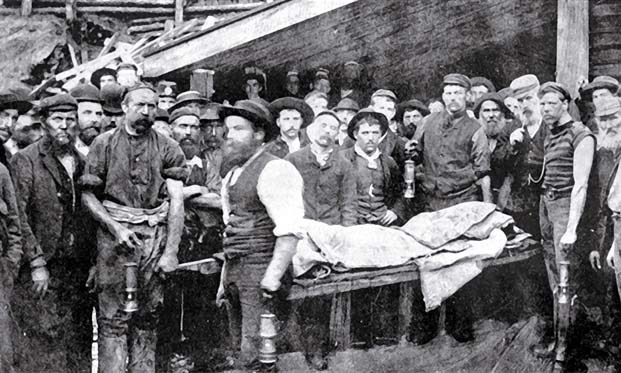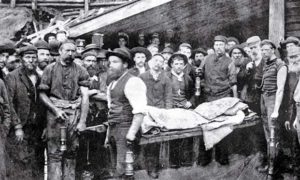By David McMillan
The “first great mining disaster”, as it was labelled by the Coolgardie Mining Review, occurred on 31 March 1897 but its significance wasn’t apparent until the next day and no deaths actually occurred on that date.
On Wednesday night, five miners were working at the 300ft level of the Mt Charlotte GM, Kalgoorlie, preparing to fire charges in the shaft a further 90ft below. For light, the men had a candle fixed in a candlestick holder, know as a “spider”, which had a hook for hanging. In this case, it was hung on a wooden box in which loose plugs of dynamite were kept, with the candle to the inside of the box, to enable the “chargeman”, Charles Milsom, to see what he was doing.
While Milsom was away, the candle, having burnt low, slipped through the socket of the spider into the box, igniting the dynamite. John Murphy quickly seized the candle and threw it away. The others ran for the shaft, ringing for the cage, followed by Murphy, and scrambled up the ladder way as fast as they could. Lying along side the candle box was a box of detonators, and these exploded from the heat, potentially causing a more serious explosion of dynamite.
This drove the fumes from the burning dynamite out along the drive and up the shaft where the miners were climbing for dear life. Three hundred feet of ladders would tax any man but being engulfed in foul and suffocating fumes must have been a bitter struggle. The alarm had been given to two men working the level above and they joined the fatal upward climb. Two failed to reach the surface, having fallen exhausted on one of the landings. When this was learned from men reaching the surface, volunteers descended into the fumes and brought them up.
Brandy was administered to the men, who were very much distressed, but they were able to walk to their respective camps.
In the morning Milsom was found to be very ill and was conveyed to the Government Hospital where he died two hours later. He was a married man of about 50yrs and his son worked at the same mine.
The other affected men did not regard themselves in a grave plight but Dr Gibson had four of them removed to the hospital. Frank McAdam, 43, was very ill. John Murphy, 38, was received at the St John of God Hospital that evening and died two hours later. At about the same time, friends brought James McGauchie, 47, to the same hospital, shortly followed by John Wickcroft, 45. Ken Wilson, 39, suddenly expired at his home on the mine with his wife and five children present. McGauchie died that night, leaving a wife and seven children in Victoria who were dependent on him. Wickcroft died six days later. Several other men were affected but returned to work over the next few days. Frank McAdam recovered and went to work for several weeks before being readmitted into hospital and dying on the 7 May.
According to the medical staff, inhalation of dynamite fumes has the effect of filling the lungs with liquid, making breathing terribly difficult, causing suffocation.
In the meantime, the underground manager went through the mine and determined that the fire had burnt itself out. While the fumes had gone up the shaft, the other workings were unaffected. If the men had not gone up the shaft, but remained on the plat or taken refuge in the 300ft workings, they would have escaped injury. But of course, the first thought is always to get to the surface.
Four wives and 19 children were bereft of income, so various fund-raising actions were taken, including concerts and balls, in mining towns throughout the goldfields.
The Inspector of Mines was more concerned with the impact on his statistics:
…this gives a rate of two deaths per thousand. In itself this cannot be regarded as being an abnormally high average; but that it is as high as it is, is due to the Mt Charlotte disaster. At that mine, in April last, six men succumbed to the effects that resulted from an inhalation of the fumes of burning nitro-glycerin compounds. Some quantity of this material was accidentally set on fire in the mine, and the men, in making their escape, were exposed to the resulting fumes. Eliminating these six deaths, the rate is reduced to one per thousand of mining population.
—Report of the Department of Mines 1897, page 77





